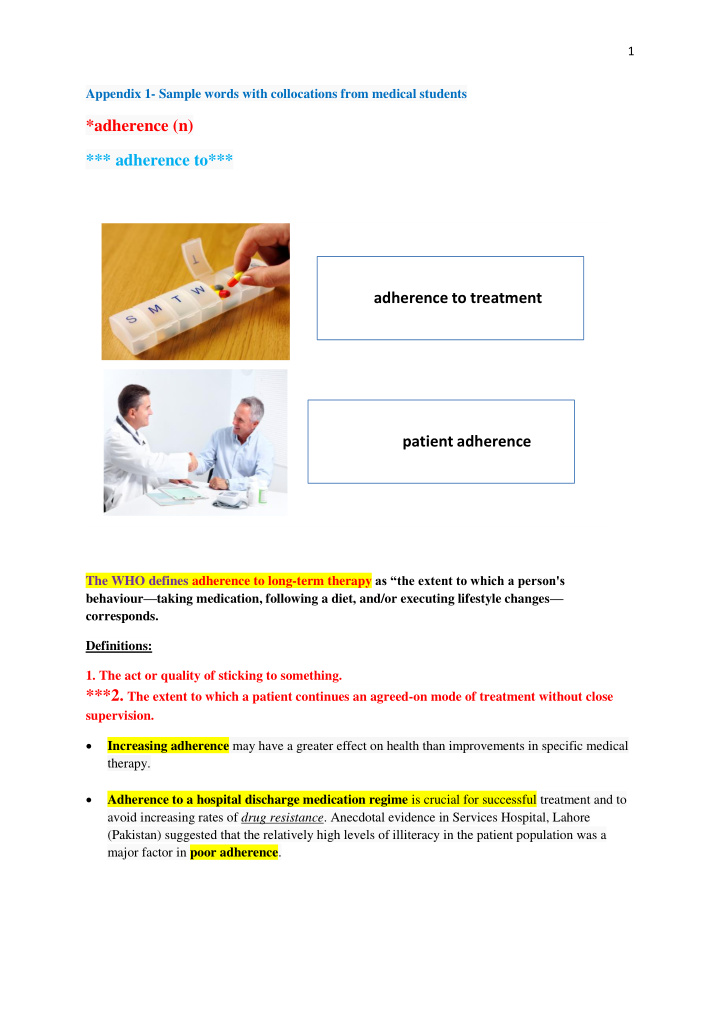



1 Appendix 1- Sample words with collocations from medical students *adherence (n) *** adherence to*** adherence to treatment patient adherence The WHO defines adherence to long-term therapy as “the extent to which a person's behaviour — taking medication, following a diet, and/or executing lifestyle changes — corresponds. Definitions: 1. The act or quality of sticking to something. ***2. The extent to which a patient continues an agreed-on mode of treatment without close supervision. Increasing adherence may have a greater effect on health than improvements in specific medical therapy. Adherence to a hospital discharge medication regime is crucial for successful treatment and to avoid increasing rates of drug resistance . Anecdotal evidence in Services Hospital, Lahore (Pakistan) suggested that the relatively high levels of illiteracy in the patient population was a major factor in poor adherence .
2 Poor adherence to medical treatment severely compromises patient outcomes and increases patient mortality. According to the WHO, improving adherence to medical therapy for conditions of hypertension, hyperlipidemia, and diabetes would yield very substantial health and economic benefits. Adherence is a key factor associated with the effectiveness of all pharmacological therapies but is particularly critical for medications prescribed for chronic conditions. Numerous empirical studies from various populations and settings link patient treatment adherence to physician-patient communication . Patient adherence – the degree to which patients follow the recommendations of their health professionals – is a salient outcome of the process of care. For the purposes of this study, patient adherence was defined as following medical treatment or prevention recommendations prescribed by a physician and each article was coded for how adherence was measured (self-report or objective measure or measured by health professional), study design for adherence measurement and time if applicable (longitudinal, cross-sectional, retrospective), and regimen for which adherence is measured (medication, health behavior, appointment-keeping). Adherence to therapy is especially important for management of chronic diseases, such as diabetes, heart disease and cancer. The initiation of treatment with half a tablet was optional. Adherence to the treatment regimen was assessed quarterly on the basis of pill counts and structured interviews. Previous studies have not demonstrated that drugs used to treat diabetes are effective for its prevention, perhaps because of small samples and the lack of data on adherence to the prescribed regimens . In the study, hospitalization s, adherence to the study regimen , and side effects was systematically recorded at each follow-up visit. For participants who did not complete the study, the time to withdrawal was compared between the two groups with the use of the log-rank test. For each group, the rate of adherence to treatment , based on pill counts at the 6-week visit and the 12-week visit, was calculated as the average of the percentage of pills taken.
3 * prevalence (n) ***prevalence of prevalence rates Definition: The number of people with a disease or condition in a given population at a specific time, either a poin t in time ( point prevalence ) or over a period of time ( period prevalence ). Epidemiologic studies of the prevalence of rheumatic heart disease have used clinical screening with echocardiographic confirmation of suspected cases. We hypothesized that echocardiographic screening of all surveyed children would show a significantly higher prevalence of rheumatic heart disease. Clinical examination detected rheumatic heart disease that was confirmed by echocardiography in 8 of 3677 children in Cambodia and 5 of 2170 children in Mozambique; the corresponding prevalence rates and 95% confidence intervals (CIs) … Exact prevalence data are also highly desirable to facilitate health care planning.
Recommend
More recommend